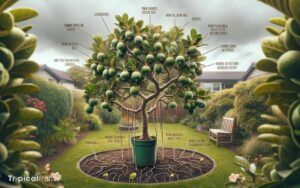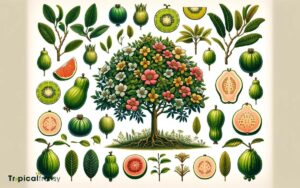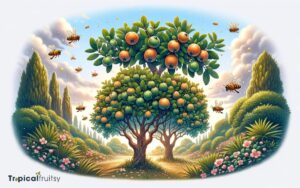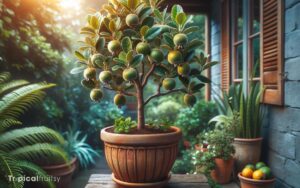What Does a Feijoa Tree Look Like? Green Majesty!
A Feijoa tree, also known as Acca sellowiana, is an attractive evergreen shrub that typically grows between 10-15 feet in height. It features dense, rich green foliage with glossy dark green leaves that have a silver-gray underside.
The tree is renowned for its beautiful flowers and edible fruit. In spring, it produces spectacular white flowers with red accents, followed by oval-shaped, green fruits with a sweet and aromatic flavor.
The Feijoa tree is native to South America and is well-regarded not only for its fruit but also for its ornamental value.
Here are key characteristics:
The Feijoa tree offers year-round visual appeal and a bountiful harvest, making it a dual-purpose addition to any garden.
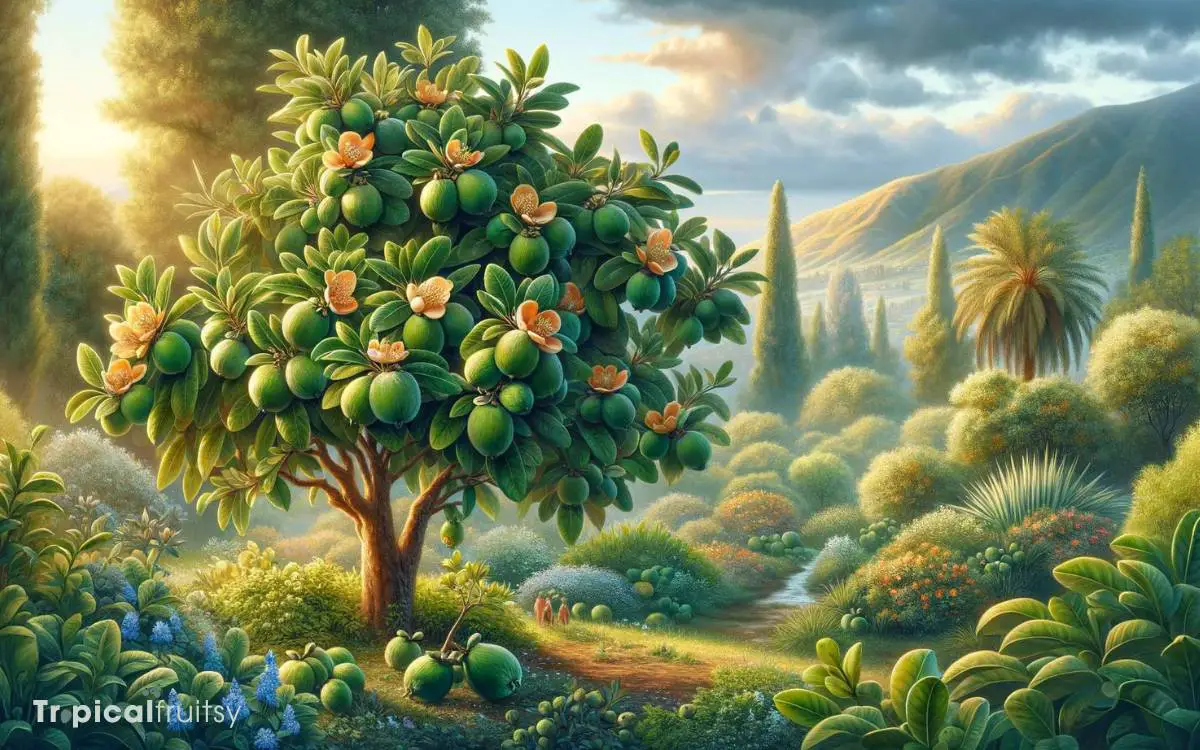
Key Takeaway
Feijoa Tree Identification and Characteristics
| Characteristic | Description |
|---|---|
| Type | Evergreen shrub/tree |
| Native to | South America |
| Average Height | 10-15 feet |
| Leaf Color | Dark green with a silvery underside |
| Flower Appearance | White petals with crimson stamens |
| Fruit Description | Egg-shaped, sweet, aromatic |
| Bark Texture | Smooth |
| Bark Color | Greyish |
| Growth Habit | Rounded, bushy |
Origins and Species
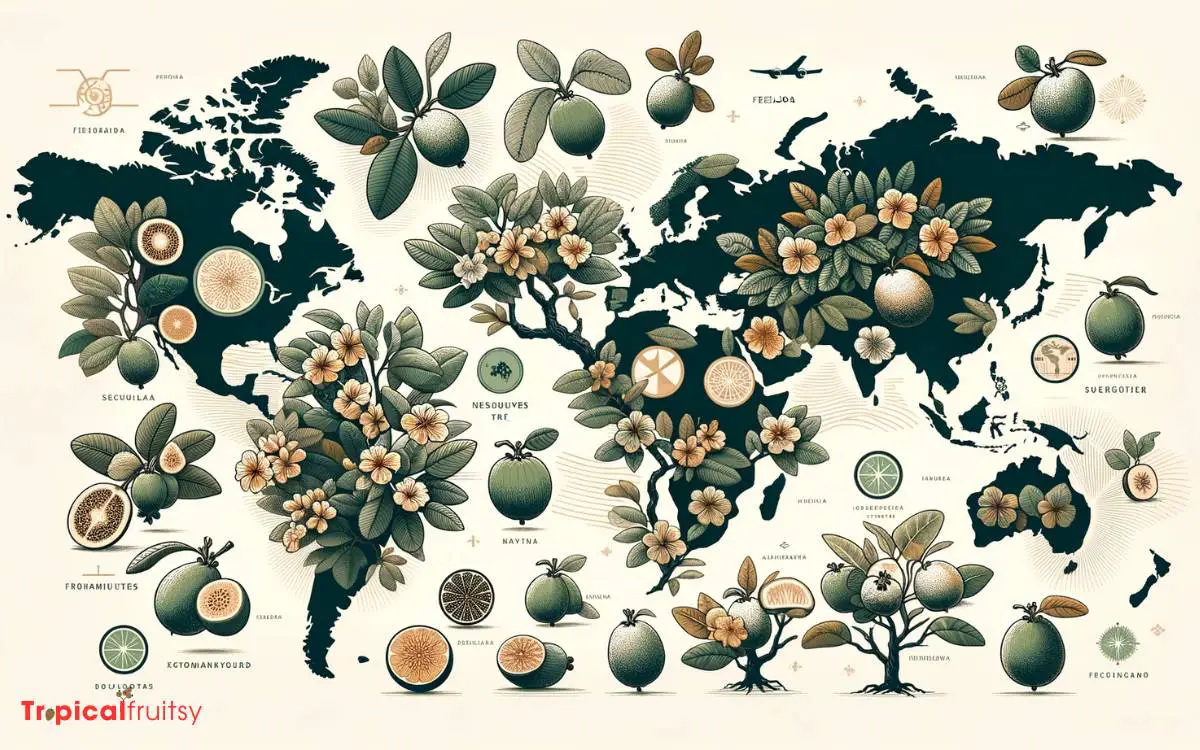
The feijoa tree, also known as Acca sellowiana, originates from the highlands of South America and belongs to the Myrtaceae family. It’s a perennial shrub, which matures into a small tree with a broad, dense canopy.
The species has adapted to a range of soils but flourishes in well-drained, slightly acidic substrates rich in organic matter. It’s hardy to USDA zones 8-10, tolerating brief frosts.
Feijoa’s elliptical leaves exhibit a distinctive silver-green hue, with a soft, felt-like texture on the underside. During its blooming season, the plant produces striking flowers.
These feature fleshy white petals with prominent red stamens, which not only contribute to the plant’s ornamental value but also attract pollinators.
The tree’s fruit, the feijoa, is an ellipsoid berry with a sweet, aromatic flavor.
Feijoa Tree Size
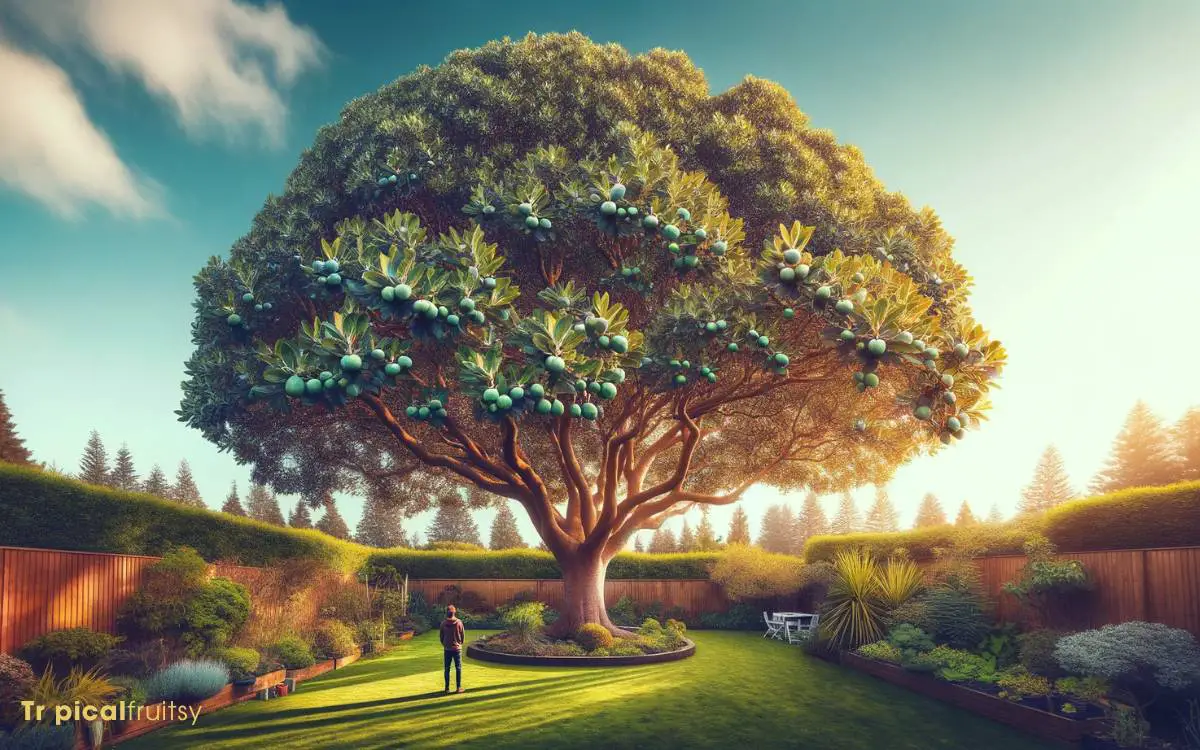
Feijoa trees typically reach a height of 1-7 meters and develop a spread width of similar dimensions, creating a roughly symmetrical canopy.
The growth rate of these trees is moderate, with optimal conditions leading to faster development.
To ensure precise knowledge of the feijoa tree’s dimensions, cultivators must consider both genetic and environmental factors.
Height Range
Typically, a mature feijoa tree reaches a height between 10 to 15 feet, although it can extend to 20 feet under ideal conditions. The tree’s stature is influenced by several factors, including genetic variation, soil fertility, and water availability.
These trees exhibit a bushy, multi-stemmed growth habit, which contributes to their sometimes-rounded canopy.
The height range is crucial for understanding spatial requirements for cultivation, ensuring that adequate space is allocated for optimal growth.
It’s important for gardeners to consider this when planting to prevent overcrowding and to facilitate sufficient sunlight exposure and air circulation.
Pruning practices may also affect the vertical growth of feijoa trees, enabling cultivators to manage the tree’s height within the aforementioned range for both agricultural and ornamental purposes.
Spread Width
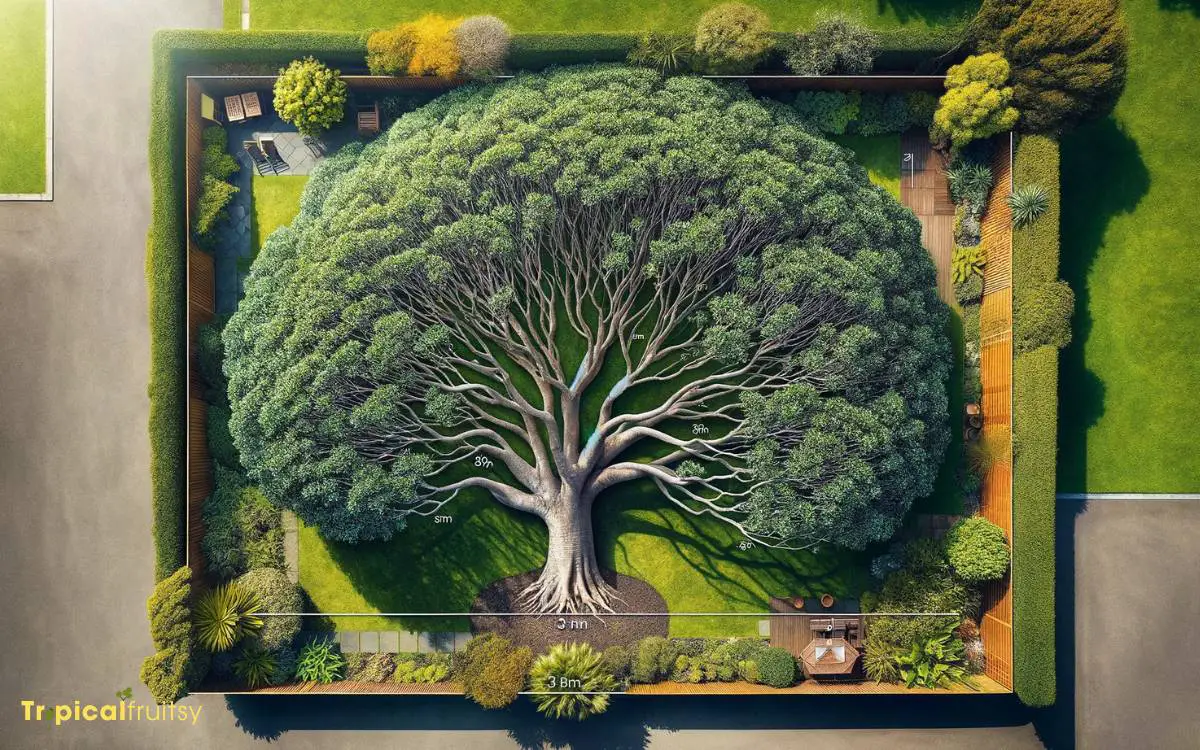
One should note that a feijoa tree’s spread can be as wide as it’s tall, often reaching up to 15 feet across. This lateral growth necessitates consideration in landscaping designs to ensure adequate space for the mature canopy.
The spread of the tree isn’t only a function of genetic disposition but also influenced by environmental conditions and cultivation practices.
- Site Selection: Feijoa trees require ample space for a symmetrical canopy development.
- Pruning: Regular pruning can control and shape the spread.
- Sunlight Exposure: Adequate sunlight encourages an even spread.
- Soil Conditions: Well-draining soil promotes healthy root expansion, affecting canopy width.
Understanding these factors allows gardeners to manage the spread effectively, ensuring the tree’s health and productivity while maintaining aesthetic appeal.
Growth Rate
Considering the space a feijoa tree occupies, its growth rate is relatively fast, with young trees capable of reaching full size within a few years.
This rapid development is critical for gardeners who aim to establish a mature landscape expediently. The feijoa tree, scientifically known as Acca sellowiana, exhibits a moderate to rapid growth under optimal conditions.
| Year | Height Range | Width Range |
|---|---|---|
| 1 | 1-2 ft. | 0.5-1 ft. |
| 2 | 2-4 ft. | 1-2 ft. |
| 3 | 3-6 ft. | 2-3 ft. |
| 4 | 4-8 ft. | 3-4 ft. |
| 5+ | 6-10+ ft. | 4-7+ ft. |
Mature feijoa trees can reach heights of 10-15 feet with a spread of 15 feet, depending on environmental factors and care.
Distinctive Leaf Characteristics
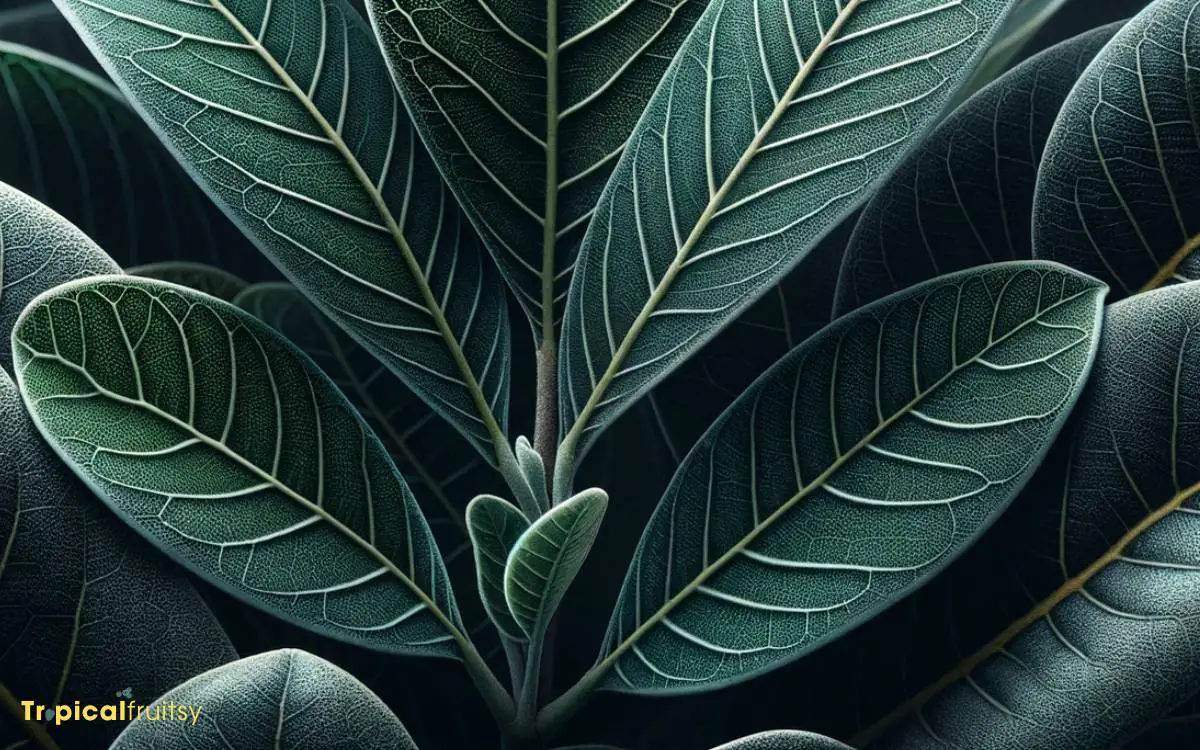
The feijoa tree’s foliage exhibits a unique silvery-green hue, a characteristic that serves as a key identifier for the species. Its leaves are elliptical in shape, maintaining a consistent form throughout the tree’s canopy.
This leaf morphology not only contributes to the tree’s aesthetic but also reflects its adaptive traits within its native habitat.
Silvery-Green Foliage
A feijoa tree’s leaves are immediately recognizable by their silvery-green color, which adds a unique texture to the plant’s appearance.
The foliage isn’t only visually striking but also exhibits several botanically significant features:
- Elliptic to oblong-ovate leaf shape: This morphology aids in maximizing photosynthetic efficiency while minimizing water loss.
- Glaucous leaf surface: The waxy, silver-white coating reflects sunlight, reducing leaf temperature and water loss through transpiration.
- Opposite leaf arrangement: This configuration optimizes light capture and may enhance the structural stability of the branches.
- Thick leaf texture: The robustness contributes to drought tolerance, an adaptive trait for survival in various climatic conditions.
Understanding these characteristics helps one appreciate the feijoa’s adaptability and ornamental value in horticulture.
Elliptical Leaf Shape
Feijoa trees feature an array of elliptical leaves that serve as one of its most distinctive characteristics.
These leaves exhibit a pronounced ovate-elliptical shape, which is broadest at or just above the middle and tapers towards both the apex and base, creating a smooth, elongated form.
Typically, the leaves measure between 1.5 to 3 inches in length, and their margins are entire and smoothly contoured, lacking serration or lobing.
The leaves’ anatomical structure is adapted for efficiency in photosynthesis while minimizing water loss, a vital trait for the species’ survival in its native South American climates.
The upper surface presents a glossy green appearance, while the underside is characterized by a dense, silvery-grey tomentum, which reflects sunlight and reduces transpiration.
Seasonal Changes in Appearance
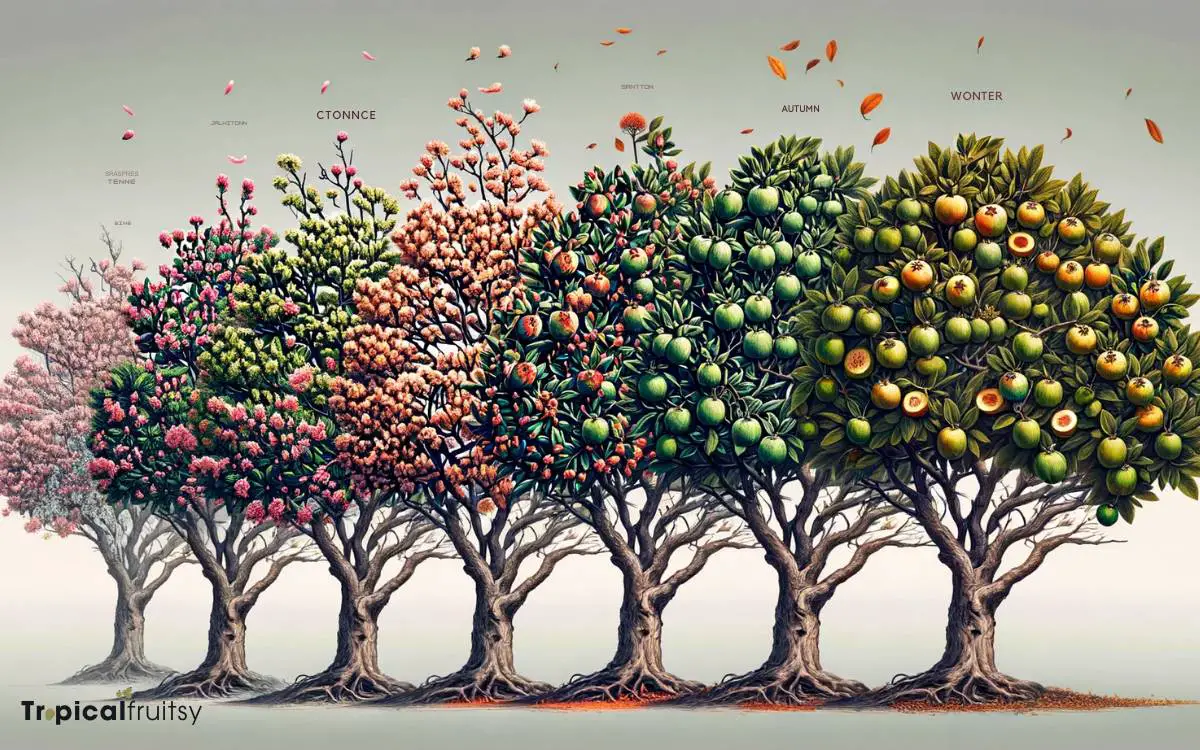
Throughout the year, a feijoa tree’s appearance transitions significantly, reflecting the seasonal shifts in weather and light.
These changes manifest in several ways:
- Spring: The tree bursts into life with dense, lush foliage and distinctive flowers.
- Summer: Photosynthetic activity peaks, and the canopy expands with mature, dark green leaves.
- Autumn: Fruit development is evident as the feijoa matures, sometimes accompanied by a slight yellowing of leaves.
- Winter: Leaf fall can occur in colder climates, leading to a sparser appearance, while in milder regions, the tree may retain much of its foliage.
Understanding these seasonal dynamics is crucial for proper tree care and maximizing fruit yield.
Unique Flower Features
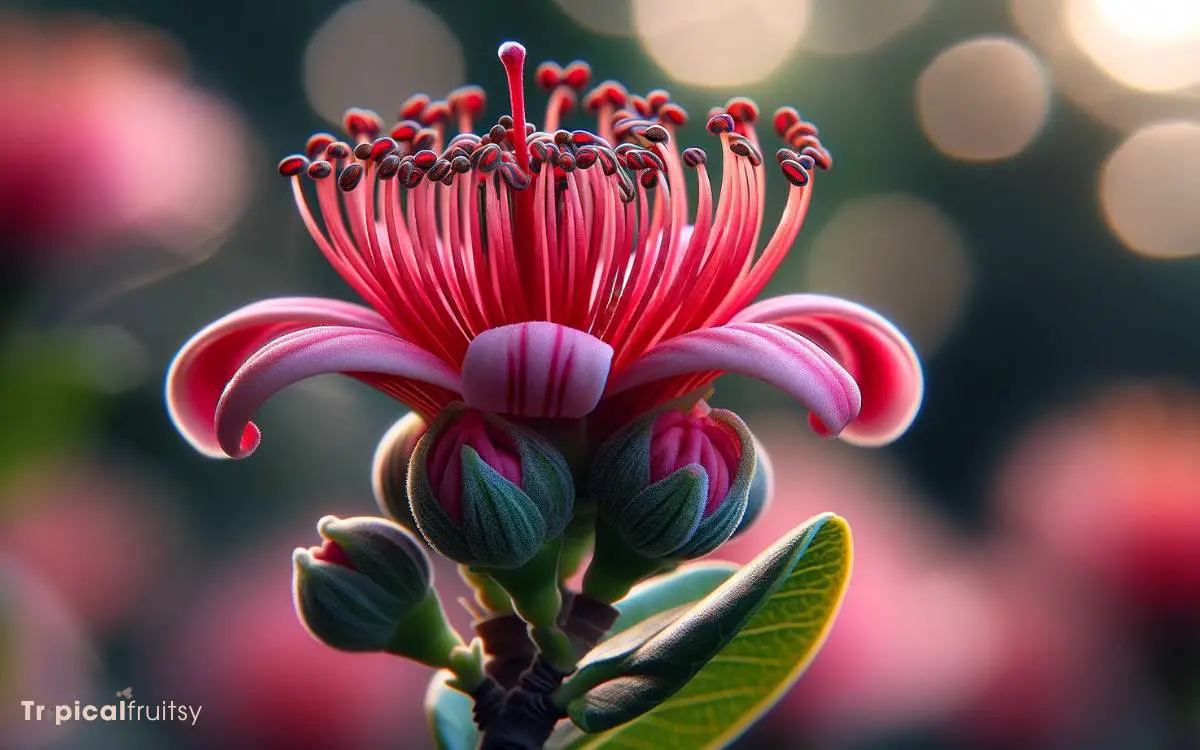
Amidst its seasonal transitions, the feijoa tree showcases striking flowers characterized by their vibrant pink petals and pronounced stamens, which play a critical role in attracting pollinators.
Each flower consists of four to six fleshy petals with a unique, edible quality. The interior of the bloom features prominent, bright red stamens topped with yellow anthers, rich in pollen.
These stamen structures aren’t only vital for reproductive success through pollination but also serve as a visual and olfactory lure for birds and insects.
The petals, inversely oblong and waxy in texture, form a bell-like structure that protects the sexual organs of the flower.
This intricate floral architecture ensures effective pollinator visits, setting the stage for subsequent fruit development and maturation.
Fruit Description and Development
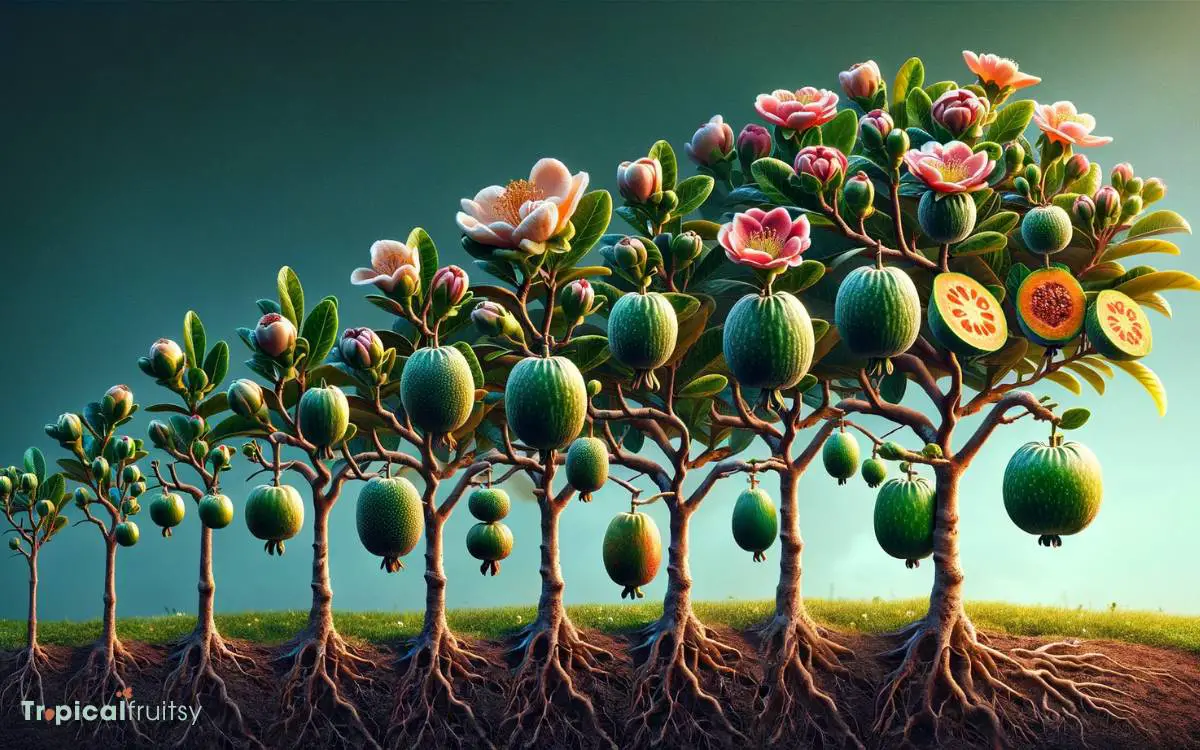
How do the unique flowers of the feijoa tree give way to its distinctive fruit? Following pollination, the feijoa flower’s ovary begins to develop into the fruit.
This process is marked by the enlargement of the ovary, and the petals typically drop away. The fruit matures on the tree for several months before it’s ready for harvest.
Key aspects of feijoa fruit development include:
- Growth Phase: The feijoa fruit swells over time, assuming an ellipsoid or oval shape.
- Size: Mature fruits generally range from 4 to 8 cm in length.
- Surface Texture: The skin of the fruit is thin, rough, and green, with a blueish bloom.
- Flavor Profile: The ripe fruit has a sweet, aromatic flavor with a jelly-like seeded pulp inside.
The developmental stages of the feijoa fruit are crucial for determining the optimal harvest time and ensuring the best quality of the produce.
Bark Texture and Color
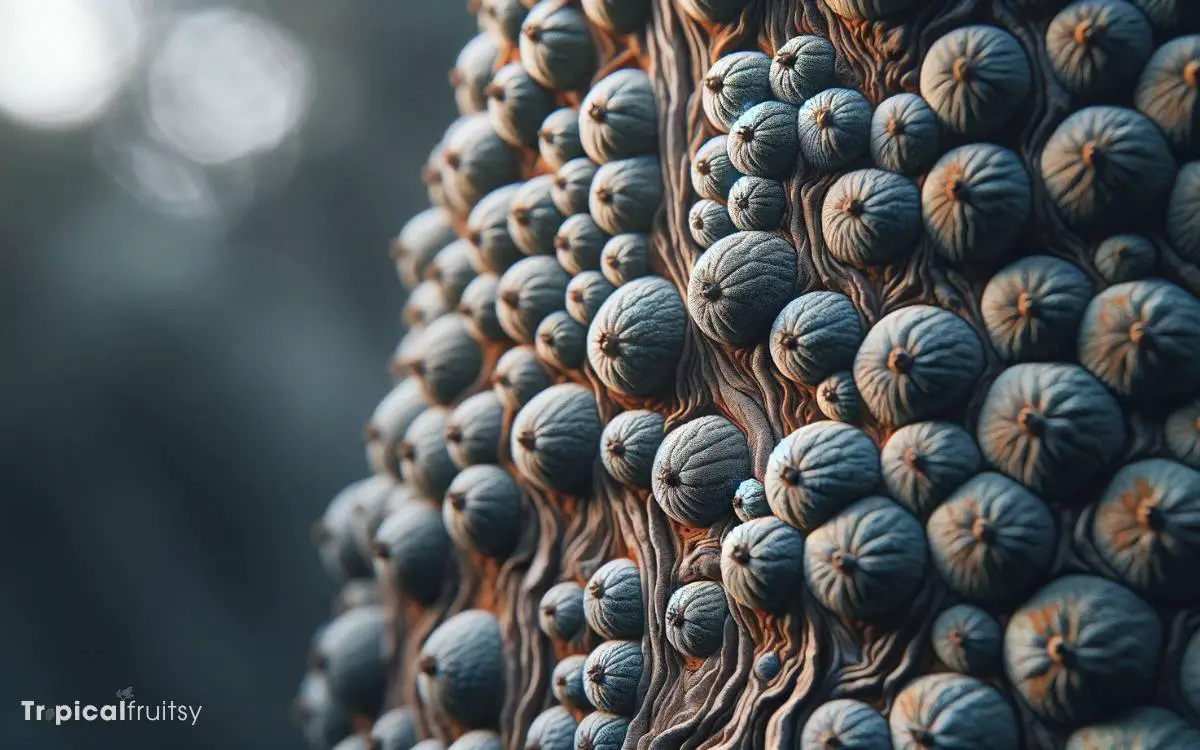
A feijoa tree’s bark is grayish-brown with a rough texture that becomes more pronounced as the tree ages.
This rugged surface is the result of the tree’s cork cambium, a type of secondary meristem, producing cork cells that accumulate and die off, forming a protective layer.
The coloration of the bark is attributable to the presence of tannins and other phenolic compounds, which help defend against pathogens and pests.
Over time, this bark can fissure and exfoliate, revealing a slightly more textured and furrowed exterior.
This bark characteristic isn’t only a defense mechanism but also an adaptive feature, facilitating the tree’s survival in various climatic conditions.
Observers will notice the bark’s resilience and its capacity to withstand environmental stresses, such as drought and temperature fluctuations.
Growth Habit and Structure
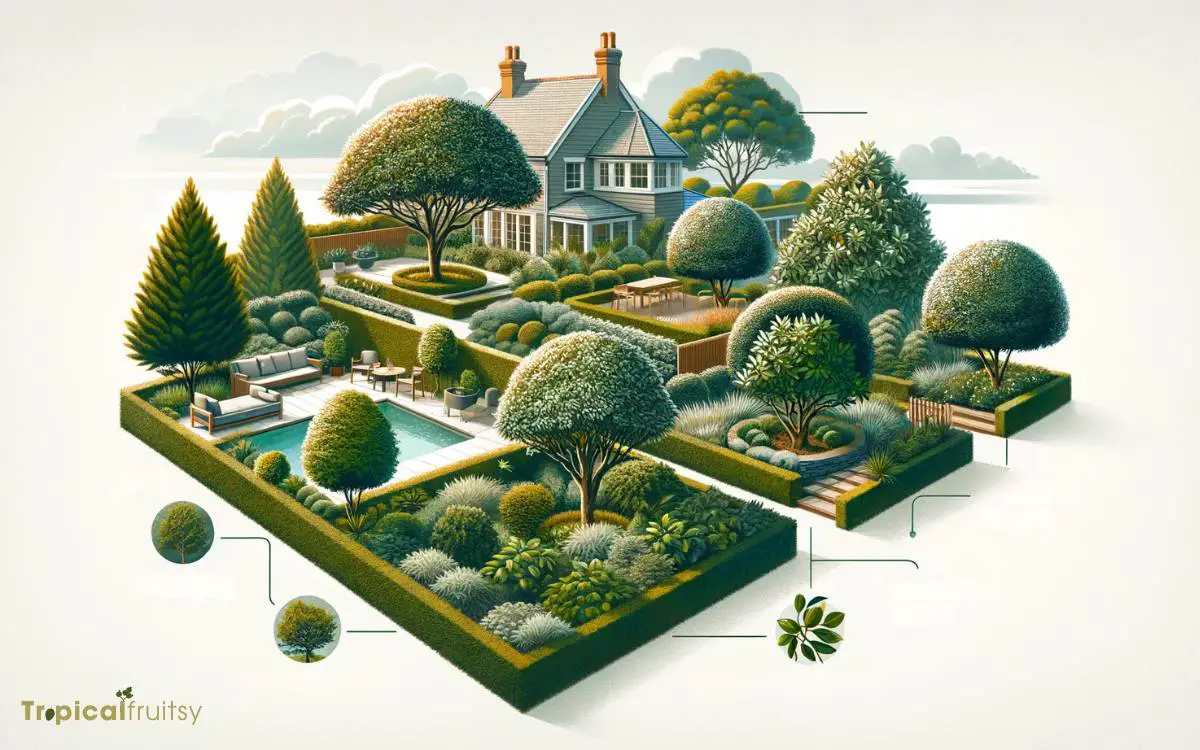
The feijoa tree’s growth habit is dense and shrubby, with a multi-branched structure that can reach up to 15 feet in height.
This evergreen species, Acca sellowiana, displays a symmetrical canopy when mature, due to its consistent and radial branch proliferation.
Its robustness and compact form endow it with stability, making it suitable for both ornamental and practical applications in various landscapes.
Key structural characteristics include:
- Pronounced apical dominance, leading to a central leader in younger specimens
- Horizontal to slightly drooping branches, providing structural complexity
- Leaf arrangement: opposite to sub-opposite, contributing to the density of foliage
- Internodal distance: relatively short, resulting in a lush, leafy appearance
Understanding these growth patterns ensures accurate identification and optimal horticultural practices for the feijoa tree.
Landscape Uses and Companions
Feijoa trees serve as both attractive focal points and practical windbreaks within the landscape. They are often accompanied by flowering shrubs and perennial plants that thrive in similar conditions.
Landscapers value the feijoa for its versatility and ease of integration into various garden themes. The tree’s compact canopy and tolerance for pruning make it an excellent choice for hedging and topiary work.
When selecting companion plants, one must consider those with compatible growth requirements. Species that prefer well-drained soils and a subtropical to temperate climate pair well with feijoas.
These include lavender, rosemary, and other Mediterranean herbs that share the feijoa’s need for full sun and moderate watering.
Moreover, the feijoa’s dense foliage provides beneficial microclimates for understory plants sensitive to harsh sunlight.
Conclusion
The feijoa tree flourishes with foliage that’s both lush and leathery, flaunting flamboyant flowers and fabulous fruit.
Its bark boasts a bronzed beauty, while the growth pattern provides a picturesque presence, perfect for pairing with plants of parallel preferences.
With a structure that’s suitably sturdy and a size that’s sensibly scaled, the feijoa finds favor in functional and ornamental landscapes alike, fulfilling the fantasies of fruit-farming aficionados and foliage fans.



